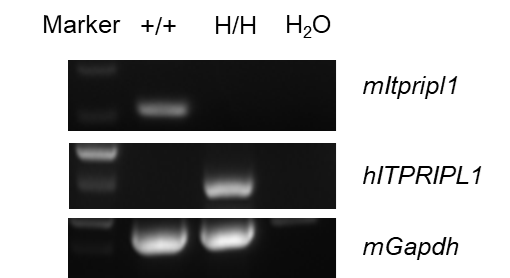Description
- The ITPRIPL1 (Inositol 1,4,5-Trisphosphate Receptor Interacting Protein-Like 1) gene encodes a protein implicated in T cell regulation by interacting with the CD3ε molecule. It is located on chromosome 6. The ITPRIPL1 protein acts as an inhibitory ligand for CD3ε, thereby modulating T cell activation in the tumor microenvironment.
- This interaction significantly reduces calcium influx and phosphorylation of ZAP70, which are critical steps in the T cell activation pathway. The downregulation of these processes by ITPRIPL1 suggests its role in immune response modulation and tumor immune evasion. Given its regulatory functions, ITPRIPL1 has become a subject of research for its potential implications in cancer immunotherapy and as a biomarker for diagnosing and prognosticating various cancers.
- The exons 2 of mouse Itpripl1 gene that encode part of extracellular domain and part of transmembrane domain was replaced by human counterparts in B-hITPRIPL1 mice. The genomic region of mouse Itpripl1 gene that encodes cytoplasmic portion was retained. The promoter, 5’UTR and 3’UTR region of the mouse gene were also retained. The chimeric ITPRIPL1 expression is driven by endogenous mouse Itpripl1 promoter, while mouse Itpripl1 gene transcription and translation will be disrupted.
- ITPRIPL1 were detectable in cerebellum, testis and kidney in wild-type mice and homozygous B-hITPRIPL1 mice. The antibody was cross-reactive between human and mouse.
- Mouse Itpripl1 mRNA was detectable in wild-type mice. Human ITPRIPL1 mRNA was detectable only homozygous B-hITPRIPL1 mice but not in wild-type mice.
- B-hITPRIPL1 mice can be used to study the in vivo efficacy and safety evaluation of ITPRIPL1 antibody drugs.
Targeting strategy
Gene targeting strategy for B-hITPRIPL1 mice. The exons 2 of mouse Itpripl1 gene that encode part of extracellular domain and part of transmembrane domain was replaced by human counterparts in B-hITPRIPL1 mice. The genomic region of mouse Itpripl1 gene that encodes cytoplasmic portion was retained. The promoter, 5’UTR and 3’UTR region of the mouse gene were also retained. The chimeric ITPRIPL1 expression is driven by endogenous mouse Itpripl1 promoter, while mouse Itpripl1 gene transcription and translation will be disrupted.
mRNA expression analysis
Strain specific analysis of ITPRIPL1 mRNA expression in wild-type C57BL/6JNifdc mice and B-hITPRIPL1 mice by RT-PCR. Testis RNA were isolated from wildtype C57BL/6JNifdc mice (+/+) and homozygous B-hITPRIPL1 mice (H/H), then cDNA libraries were synthesized by reverse transcription, followed by PCR with mouse or human ITPRIPL1 primers. Mouse Itpripl1 mRNA was detectable in wild-type mice. Human ITPRIPL1 mRNA was detectable only homozygous B-hITPRIPL1 mice but not in wild-type mice.
Protein expression analysis
Western blot analysis of ITPRIPL1 protein expression in homozygous B-hITPRIPL1 mice. Various tissue lysates were collected from wild-type C57BL/6JNifdc (+/+) mice and homozygous B-hITPRIPL1 mice (H/H), and then analyzed by western blot with anti-ITPRIPL1 antibody (Thermo, PA5-31771). 40 μg total proteins were loaded for western blotting analysis. ITPRIPL1 were detectable in cerebellum, testis and kidney in wild-type mice and homozygous B-hITPRIPL1 mice. The antibody was cross-reactive between human and mouse.
* When publishing results obtained using this animal model, please acknowledge the source as follows: The animal model [B-hITPRIPL1 mice] (Cat# 113678) was purchased from Biocytogen.


